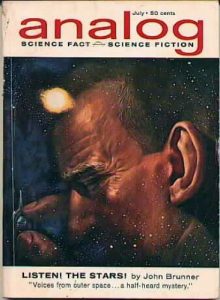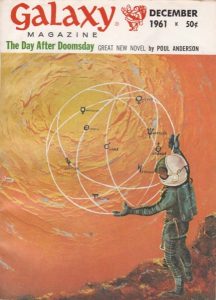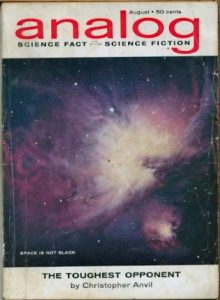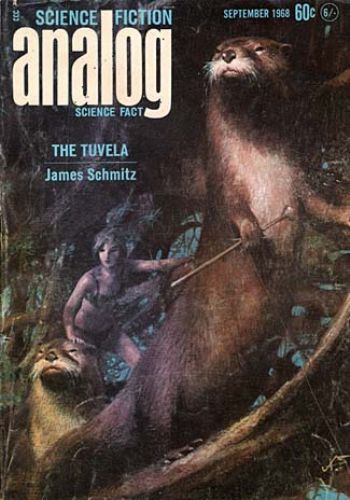For the first quarter of 2020, my Wednesday interviews will be with authors who are part of When Valor Must Hold, the upcoming anthology of fantasy stories published by Chris Kennedy Publishing.
This week’s interview comes from Quincy J. Allen, a fantastic author who’s already made a name for himself though I think he’s still a rising star. His story is a Fistful of Silver, set in his Guardians of Pelinon universe, and it’s something as if Raymond Chandler wrote Sparhawk instead of David Eddings. Needless to say, I loved it.
Interview: QJ Allen

Why are you here?
- What are your influences?
Jullian May, Robert Heinlein, Roger Zelazny, Keith Laumer, Jack Chalker, Kenneth C. Flint, Poul Anderson, Steven Brust - Who are some favorite other creators?
Katsuhiro Otomo (Akira), Ridley Scott (Blade Runner), Frank Herbert (Dune), Olaf Stapledon (Last and First Men), Gene Roddenberry (Star Trek), Jon Favreau (EVERYTHING) - What made you a creator in the first place?
Seriously, though, I wrote my first fiction story in the 3rd or 4th grade. I’ve always written. Writing got me through primary, secondary, Bachelors, and Masters education. It was always there in every professional job I ever had. And when I got RIFed in 2009, it made more sense to just try and be a professional writer. - Why did you choose to create what you create?
As a boy, I read the Jupiter Jones mysteries and loved them. A few years later, my older brother handed me his copy of “The Science Fiction Hall of Fame,” and I was hooked. There was no going back, and I devoured science fiction and sci-fi crossed with others from there on out. I read fantasy, but my staple was science fiction. When I discovered Julian May’s “The Many Colored Land” series, which is pure cross genre between sci-fi and fantasy, I truly fell in love. So, I’ve written what I love as much as possible. - What would someday like to create.
The entire Blood War Chronicles series of six books is a setup so that I can write Skeeter’s story as a 30-year-old airship privateer captain gunslinger sorceress engineer. So, that will be a thing. I also plan on writing a three-book series set in that same universe that connects the three great fires of the 19th century via a Jesuit witch/demon hunter. I’ll be writing a powered armor series as well as a new fantasy series involving druids. But I have to get my current commitments behind me, and that’s no mean feat.

Describe your great Lab of Creation?
- Where do you work? Home? Coffee Shop?
I take my laptop everywhere when I travel with my wife. She travels for her job, so I sometimes get to tag along for free trips. She has mad hotel and airline points. My actual workspace, however, is in our two story shop in the back yard. It triples as her sewing room, my actual work shop for carpentry, repairs, leather working, and whatnot, as well as a three-monitor workstation where I used to also run a small book design and author collateral marketing business. I spend most of my waking time out in a shop so I can open the doors in the summer and use the kerosene heater in the winter. - Do you listen to music? If so, give some examples.
I’ve never been able to work without music. It drove my old man crazy when I was a kid, but that part wasn’t negotiable. The first thing I do when I get into the shop is fire up Pandora. As to my music tastes, they’re more expansive than anyone I’ve ever met, and they can be quite eclectic. On any give day, you can hear Pentatonix, Joe Bonamassa, The Hu (Mongolian death metal), Steely Dan, Steam Powered Giraffe, Bach, Mozart, Five Finger Death Punch, electronica, daft punk, techno, Celtic—pretty much everything except modern country twang and most rap. Those two are a hard no, Bob. - What other things exist in your productive environment?
Cigars and my tobacco pipe. I work better with them. Oh, and COFFEE. Always coffee in the morning. And whenever I can manage it, fresh air and the sound of birds. Our house is surrounded by trees here in North Carolina. I come from Colorado, where there aren’t many trees until you get to the mountains. Here, it’s pretty much a friggin bird sanctuary, and I love it. It’s one of my favorite parts of the Carolinas. - What things have you tried that haven’t worked?
Romance writing, for one. I don’t have a knack for literary fiction either. That stuff bores the shit out of me. I’ve written variations on just about all of the genres, however. Science fiction, mystery, noir, fantasy, steampunk, horror, speculative… most of my stories mix at least two of those.
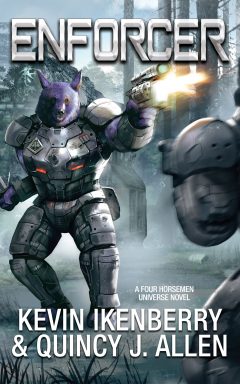
What are your superpowers?
- What kinds of things do you like in your creations?
I’ve been told (and I agree) that I do three things fairly well. Fight scenes, dialogue, and descriptions. I’ve also been honing my skills with world building, and I think I’ve finally gotten pretty good at that. If I had to pick one, though, it would probably be hand-to-hand fight scenes. I used to train in martial arts pretty heavily, even with a marine and a Green Beret. I can see a fight in my head, and that seems to translate pretty well to the written word. That’s the rumor, at least. - What are specific techniques you do well?
I’ve done it on three separate instances, and in all of them, the process was smooth and the output worth the effort. I’ve gotten pretty good at outlining as a result of those projects, although my outlines become a mix of bullet points and dialogue. I’ve also gotten pretty good at popping up prose with a more active voice. There are hiccups from time to time, but I’ve mostly broken myself of the passive voice devil. - What are some favorite successes you’ve achieved, especially things you had to struggle to overcome?
One certainly was passive voice. Also, as a result of working with Marc Edelheit, I’ve gotten much better at flowing from one scene into the next. Looking back, I think there were pieces of a story that I skipped over. The result wasn’t jarring, per se, but what I’m doing now is much smoother as one reads through my prose. Also, I think I’ve gotten at least competent as capturing a single, targeted emotion that I want the reader to experience by the end of a story. Most of the time, especially in my short fiction, I strive to make the reader “feel” something very specific. Be it honor or sacrifice or duty or whatever, I’ve learned to write entire stories so that most of the prose leads to that experience.
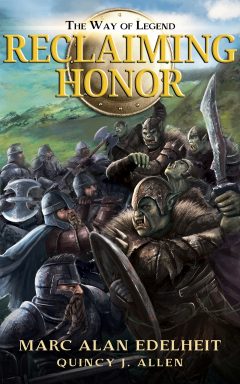
What will Lex Luthor use to defeat you?
- What are some of the challenges you have faced that frustrated you?
The first is sticking with a writing career when sales are lackluster or even worse. A perfect example is the Blood War Chronicles. They’re good books, with good reviews, but they haven’t created the revenue stream I’d hoped for. In fact, I’ve been at this game for ten—make that eleven—years now, and I can’t say that I earn a living with my writing. I think that’s the hardest part for most writers: sticking with this game even when you’re not selling. I often joke with a writer friend of mine, Aaron Ritchey, about how we’re “living the dream.” But that dream is the joke. We keep writing, we keep not selling the way we would like, and yet we keep writing. I think the other is that I’m really proud of at least a few short stories (Family Heirloom, Salting Dogwood, Jimmy Krinklepot and the White Rebels of Hayberry, and a few others, that I think are exceptional short stories, but they’ve never really been acknowledged for what I “think” they are. Granted, I have a bias, but I believe those stories are truly noteworthy. - Do you have any creative failures which taught you something? What were those lessons?
From a monetary perspective, I think you could call everything I ever wrote in the first nine years of my career (except one story I wrote for Larry Correia’s MHI franchise) as failures. None of them came close to providing an ROI on the time I’ve invested in them. However, that’s hasn’t slowed me down. And that’s the lesson, one I think most writers could learn from. If you keep going and keep getting better, eventually you’re bound to gain momentum. My work in recent years with Marc Edelheit, Kevin Ikenberry, and CKP are a testament to that. Last year and this year are seeing actual returns on my investment of time. The trick is to keep going and always hone your craft. - How do you overcome normal slow points like writer’s block?
I take Eric Flint’s advice. There is no writer’s block. You keep writing, because it’s your job. Either you are a writer and you write, or you’re a hobbyist who doesn’t want to earn a living at this mad career choice. - Which mistake would you try to keep other creators from making?
I’ve said this at cons and in panels dozens of times: “Don’t let the nay-sayers win.” I grew up hearing the phrase, “What? You want to be a starving artist the rest of your life.” As a young man, I listened to this “advice.” If I had started in earnest at 20 what I ended up starting at 43, I’d already be earning a living at this game. It just takes time and determination, so long as you keep getting better. So, to any writer who hears/reads this, when someone questions your desire to become a writer, just tell them to fuck off. Keep going, make sure your bills are paid, keep your bills low, and DON’T QUIT. - If you could go back and tell yourself anything about writing, what would it be?
See above. That’s the best advice anyone in this crazy game could receive. Writers have enough doubt and imposter syndrome without getting it from outside sources. Find ways to kick the nay-sayers to the curb.
Lightning Round
- Favorite Muppet? Animal, of course. Oh, and Sam the Eagle.
- Favorite Musical Performer We’ve Never Heard Of? Ian Moore and Joe Bonamassa.
- Favorite Superhero? Both the Punisher and Deadpool in a perfect tie.
- Favorite 1970s TV show? Monty Python
- Favorite Weird Color? Teal
- Favorite Sports Team? Sidney Swans
- Best Game Ever? Halo, OF COURSE. That and Mass Effect.
- Winter, Spring, Summer, or Fall? I fucking HATE snow and delight when it dies.
- Best Present You’ve Ever Received? My 2016 Moto Guzzi Audace. Vicki got that for me for my birthday last year. Nothing else compares.
- What Cartoon Character Are You? Did they make Roy Batty into a cartoon? If so, him. If not, I guess I’d have to say the dog Marc Antony in the old Warner Brother’s cartoon “Feed the Kitty.” Ask Vicki, she’ll tell you.
- Your Wrestler Name? Wrath
- Your Signature Wrestling Move? The Smash. A single fist to the crown of someone’s skull. REALLY hard.
- What Do You Secretly Plot? Convincing Vicki that we need an AR-10 and a Marlin .357 lever action rifle in the house.
- How Will You Conquer the World? By eliminating deceit everywhere.
- Best Thing From the 80s? 11:59:50 pm on 12/31/1989 — the nightmare was over.
- Favorite Historical Period? The Renaissance and dawn of looking to the stars as stars, not “the Heavens.”
- Most Interesting Person In History? The alien that gave humans blue eyes.
- Steak Temperature? Medium rare… or I’ll cut you.
- Favorite Chip Dip? Really good 7-layer dip.
- Favorite Cereal? As a kid, Honeycomb. Now, Honey Bunches of Oats topped with sliced peaches rather than milk.
- What Do You Eat For Your Last Meal? Pad Thai made by Vicki’s son, and it was REALLY good. We’re all cooks around here.
- Beverage(s) of Choice? Arnold Palmer, Costco flavored seltzer, Tennesee Mules, Margaritas, and COFFEE, lots of COFFEE.
-

Pachy Do You Have Pets? He was Vicki’s dog before I moved in, but he’s my dog too, and he’s the best hound I’ve ever known.
- What Actor or Actress Should Portray You in Your Biopic? Rutger Hauer when he was younger and not dead?
- What Question Should I Add to the Lightning Round? Favorite food(s), nemesis, favorite vice, Commandments broken or Deadly Sins enjoyed.
Tell me again where we can find your stuff?
- https://www.amazon.com/Quincy-J-Allen/e/B009C9C5SA
- http://www.quincyallen.com/
- “Reclaiming Honor” with Marc Edelheit and “Enforcer” with Kevin Ikenberry.
- Upcoming Projects: “Forging Destiny” – Book 2 of The Way of Legend with Marc Edelheit, “Scourge” – Book 2 of Hr’ent’s tale with Kevin Ikenberry, “Blood World” – Book 4 of The Blood War Chronicles, a Vorwhol novel for Kevin Steverson in his Salvage universe, and a novelization of the short story “Cradle and All” in Jamie Ibson’s universe.
And where can we find you?
- ConCarolina
- SAGA conference
- LibertyCon
- DragonCon
Do you have a creator biography?
National Bestselling Author Quincy J. Allen is a cross-genre author with a growing number of published novels under his belt. His media tie-in novel Colt the Outlander: Shadow of Ruin was a Scribe Award finalist in 2019, and his noir novel Chemical Burn was a Colorado Gold Award finalist in 2010.
Blood Oath, book 3 of his Blood War Chronicles series, debuted in February of 2019, and he is working on the fourth book in that six-book fantasy steampunk series, entitled Blood World, due out in 2020.
He co-authored the fantasy novel Reclaiming Honor with Marc Alan Edelheit in their Way of Legend series, released in October of 2019, and he is currently working on book 2 of that series. In November of 2019, he and Kevin Ikenberry published the novel Enforcer, which is set in the Four Horsemen Universe and is part of Ikenberry’s Peacemaker series. He is currently working on a novel for Kevin Steverson’s Salvage Title universe based upon the short story “Vorwhol Dishonor.”
His short story publications are numerous, including a pro sale appearing in Larry Correia’s Monster Hunter: Files from Baen, published in October of 2017 entitled “Sons of the Father,” as well as several pro-sale novelettes appearing in Chris Kennedy Publishing’s mil-sci-fi anthologies in and out of the Four Horsemen Universe. He also has two short story collections in his Out Through the Attic series, and he continues to add to his short-story credits with each passing year.
He works out of his home in Charlotte, North Carolina, and hopes to one day be a New York Times bestselling author.
Final question for you: What should I have asked but did not?
You should have asked if I only work alone or do I have a support mechanism? What keeps me going?
Then I’d answer that Vicki is my anchor and more supportive of my writing career than anyone else in my entire life.
Thanks to Quincy for taking the time to answer my questions.
If you have any suggestions or comments about this interview format, let me know so I can keep tweaking it.
Also, thanks to you for reading. If you’re interested in any of the other interviews I’ve done, you can find them all here: https://robhowell.org/blog/?cat=326. If you are a creator, especially an independent creator, and you want to be spotlighted in a future interview, email me at rob@robhowell.org.
Finally, if you want to join my mailing list, where I’ll announce every interview, as well as what’s going on in my life, go to www.robhowell.org and fill out the form (Name and Email Address) or drop me an email and I’ll add you.
Have a great day.
Rob Howell
Author of the Shijuren-series of novels
- Website: www.robhowell.org
- Patreon: https://www.patreon.com/rhodri2112
- Blog: www.robhowell.org/blog
- Shijuren Wiki: http://www.shijuren.org/World+
of+Shijuren+Home - MeWe: https://mewe.com/i/rob.howell1
- Facebook Author Page: https://www.facebook.com/robho
well.org/ - Twitter: https://twitter.com/Rhodri2112

